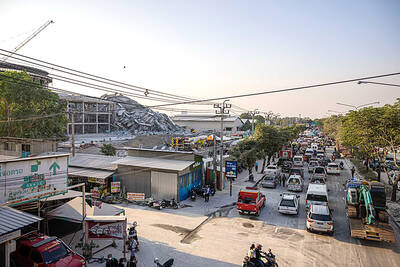French Prime Minister Francois Fillon on Monday unveiled details of a multibillion-euro stimulus plan, but admitted it would not shield France’s economy from recession.
French President Nicolas Sarkozy’s government is under pressure to show how the 26.5 billion euro (US$33 billion) package adopted by parliament last week will cushion ordinary workers from the slowdown.
Unions and the left-wing opposition are already clamoring for a second recovery plan to boost consumer spending by hiking pensions and salaries.
‘CONCRETE PROJECTS’
Four days after more than 1 million angry strikers marched to demand a state action, Fillon and 18 ministers boarded a high-speed train dubbed the “Recovery Express” to defend the plan in Lyon.
“I know that our country is gripped by doubt, by fears, by protests,” Fillon told a press conference in France’s third-biggest city, as the economy ministry announced a new raft of grim news on jobs and growth.
“We are going to fund concrete projects that support business, create work for our companies, that protect jobs,” he said, as he unveiled a list of 1,000 public works projects to benefit from state funds.
Some 870 million euros will be pumped into transport, 730 million euros into research and universities, 620 million euros into culture and heritage renovation work and 1.1 billion euros into building and renovating public housing.
The stimulus plan also includes some 1.3 billion euros in aid and hiring subsidies for small businesses, as well as 220 million euros in bonus payments to scrap polluting cars.
SMALL-SCALE PROGRAMS
Several billion more are spread across dozens of small-scale projects, from energy-efficient farming to boosting security in mental hospitals — with planned investments pulled forward to the period of this year to next year.
Split into three categories, the French stimulus plan includes 11.1 billion euros of direct state investment and 4 billion euros of investment by state-owned energy and transport firms.
Another 11.4 billion euros will come in the form of treasury facilities to help improve business cash flow.
Sarkozy’s specially appointed “Recovery Minister,” Patrick Devedjian, told reporters that 10 billion euros would be rolled out “starting this week.”
But the opposition Socialist Party dismissed the government’s announcements as “a load of hot air with little results.”
“The state is simply ... dressing up old spending as new,” said Michel Sapin, the Socialist spokesman on economic affairs.
Speaking in Lyon, Fillon conceded that the stimulus plan would not be enough to shield the French economy, which the IMF expects to shrink by about 1.9 percent this year.
French unemployment figures jumped by 45,800 in December to 2.11 million jobless, official figures showed on Monday, an 11.4 percent increase over a year.
“France is no exception to a trend that is affecting the whole of the world,” Fillon said. “What we hope is that the measures we are now taking will help France to improve its outlook compared to these forecasts.”
French Finance Minister Christine Lagarde was more explicit.
“All the countries of the eurozone will be at about minus 2” percent growth this year, she said. “We shouldn’t have any illusions.”
CAR SALES
In an echo of this message, French car makers — whose sector directly or indirectly employs 10 percent of the entire national workforce — revealed sales had tumbled 7.9 percent last month.
Sarkozy’s office announced the president would defend his economic policies in a televised speech tomorrow, as a new poll showed a majority of French people believe the government is on the wrong track.
Sixty-two percent of French voters believe Sarkozy’s stimulus plan is not an efficient weapon against the crisis, while 61 percent want unions to keep up the pressure on the government, the CSA poll of 1,002 people said.

AIR SUPPORT: The Ministry of National Defense thanked the US for the delivery, adding that it was an indicator of the White House’s commitment to the Taiwan Relations Act Deputy Minister of National Defense Po Horng-huei (柏鴻輝) and Representative to the US Alexander Yui on Friday attended a delivery ceremony for the first of Taiwan’s long-awaited 66 F-16C/D Block 70 jets at a Lockheed Martin Corp factory in Greenville, South Carolina. “We are so proud to be the global home of the F-16 and to support Taiwan’s air defense capabilities,” US Representative William Timmons wrote on X, alongside a photograph of Taiwanese and US officials at the event. The F-16C/D Block 70 jets Taiwan ordered have the same capabilities as aircraft that had been upgraded to F-16Vs. The batch of Lockheed Martin

GRIDLOCK: The National Fire Agency’s Special Search and Rescue team is on standby to travel to the countries to help out with the rescue effort A powerful earthquake rocked Myanmar and neighboring Thailand yesterday, killing at least three people in Bangkok and burying dozens when a high-rise building under construction collapsed. Footage shared on social media from Myanmar’s second-largest city showed widespread destruction, raising fears that many were trapped under the rubble or killed. The magnitude 7.7 earthquake, with an epicenter near Mandalay in Myanmar, struck at midday and was followed by a strong magnitude 6.4 aftershock. The extent of death, injury and destruction — especially in Myanmar, which is embroiled in a civil war and where information is tightly controlled at the best of times —

China's military today said it began joint army, navy and rocket force exercises around Taiwan to "serve as a stern warning and powerful deterrent against Taiwanese independence," calling President William Lai (賴清德) a "parasite." The exercises come after Lai called Beijing a "foreign hostile force" last month. More than 10 Chinese military ships approached close to Taiwan's 24 nautical mile (44.4km) contiguous zone this morning and Taiwan sent its own warships to respond, two senior Taiwanese officials said. Taiwan has not yet detected any live fire by the Chinese military so far, one of the officials said. The drills took place after US Secretary

THUGGISH BEHAVIOR: Encouraging people to report independence supporters is another intimidation tactic that threatens cross-strait peace, the state department said China setting up an online system for reporting “Taiwanese independence” advocates is an “irresponsible and reprehensible” act, a US government spokesperson said on Friday. “China’s call for private individuals to report on alleged ‘persecution or suppression’ by supposed ‘Taiwan independence henchmen and accomplices’ is irresponsible and reprehensible,” an unnamed US Department of State spokesperson told the Central News Agency in an e-mail. The move is part of Beijing’s “intimidation campaign” against Taiwan and its supporters, and is “threatening free speech around the world, destabilizing the Indo-Pacific region, and deliberately eroding the cross-strait status quo,” the spokesperson said. The Chinese Communist Party’s “threats